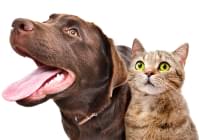Pet Obesity is a Growing Problem
The American Animal Hospital Association recently reported that pet obesity is a growing problem.
"Over the past ten years, the number of overweight cats went up 169% and the number of overweight dogs increased 158%." These numbers are concerning when you consider the multitude of health problems associated with obesity and the cost associated with addressing them. Pets who suffer from obesity have a reduced lifespan, a higher incidence of diabetes, urinary obstructions, arthritic pain, respiratory compromise, increased surgical risk, and much more.
Factors Contributing to Pet Obesity:
-
Not understanding what a healthy weight looks like. As pet obesity continues to escalate, the general population is inaccurately evaluating what a "fit" pet looks like. Getting a body condition score (BCS) done on your pet by a veterinarian is recommended.
-
Not knowing what your pet is eating. This is a leading factor in obesity. It is imperative to have control over what your pet consumes. They should be eating a nutritious, quality diet. Your veterinarian should be able to guide you in choosing an appropriate diet for your pet. It is important to know the exact quantity that is being fed. This includes treats, rawhides, etc. The most accurate way of measuring is by weighing the food with a kitchen scale; however, a measuring cup is an appropriate alternative. Keep in mind that many overweight pets may be "sneaking" food from their sibling's bowls. Keeping cat food away from dogs and feeding each pet individually is imperative when dealing with weight issues. Some pets may need additional help with weight loss and may benefit from a prescription weight loss diet.
-
Free Feeding. Many cats and dogs tend to nibble throughout the day. Just like people, this can lead to obesity. For cats, feeding towers and prey feeders are the perfect way to replicate feeding in the wild, where cats have to work for their food. Most cats benefit from a primarily canned food diet. Not only is this less calorie-dense than dry food, but the increased water content can help prevent problems such as bladder issues. For most dogs, twice daily meal feeding is recommended. Talk to your veterinarian.
-
Inappropriate use of "people food". Sharing food with our pets is tempting. Those eyes! That mournful face! He must be starving! One good rule is only to feed your pet in a designated room, from a designated bowl. This will help to prevent begging while you eat. Many people choose to supplement their pet's diet with table food. Talk to your veterinarian about what foods are appropriate to add. In general, white meat chicken, lean ground hamburger, and fruits and vegetables can be added to the diet or fed as treats. The calories in these foods must be taken into account as we strive for a healthy weight. Green beans and carrots make excellent treats for many dogs. In the summer, ice cubes are a calorie-free treat. If you prefer to cook for your pets, consult with your veterinarian. We use BalanceIt.com and other sources to make sure that homemade diets carry all the right nutrients. Keep in mind that certain foods are toxic to cats and dogs. Consult with your veterinarian.
-
Limited physical activity. Most cats and dogs do not get nearly enough exercise. Strictly indoor cats often need motivation to move, especially as they age. Using the feeding towers and prey feeders as mentioned above helps, especially if you hide the prey feeders around the house. Some cats can be encouraged to play by using a feather toy, a catnip toy, or a laser pointer. Older cats may need to be carried to the opposite end of the house from their favorite spot so they have to walk further. Placing two small food bowls as far away from each other as possible can help get them moving as well. For dogs, exercise is the key to losing weight and helping with anxiety. Exercise should be tailored to your pet's age, breed, and ability. Your veterinarian can help with an exercise program for your pet.
-
Hypothyroidism in dogs. As many dogs age, there is a reduction in the amount of thyroid hormone produced by their thyroid gland. The thyroid hormone has a huge impact on metabolism. Without enough of this hormone, their metabolism slows down and causes weight gain. Evaluating a dog's thyroid level can be easily done with a blood test, and treatment tends to be cost-effective and easy. A thyroid level should be evaluated for all overweight dogs.
A weight loss plan should include the establishment of a Body Condition Score, evaluation of your pet's diet, strict measurement of what is being fed, monthly weigh-ins and regular adjustments. Any weight loss plan should be supervised by a veterinarian.
Helping Your Pet Become More Fit
Bees Ferry Veterinary Hospital is excited to assist in improving your pet's quality of life by helping your pet become more fit. We have the tools and knowledge to help guide you. We would be happy to customize a weight loss plan for your individual pets. Please contact us for further information.





